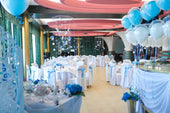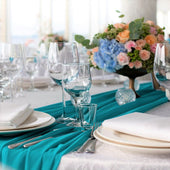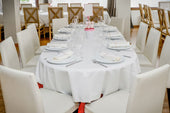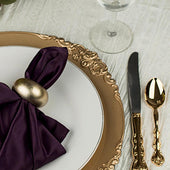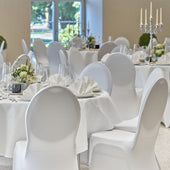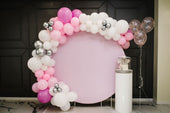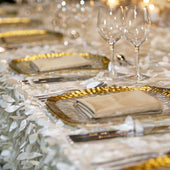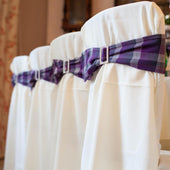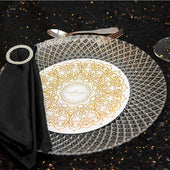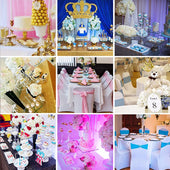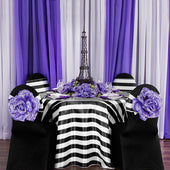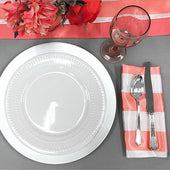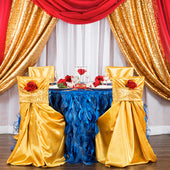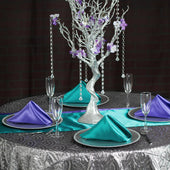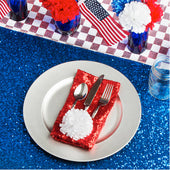Satin tablecloths and chair covers add a touch of class to any event, and they look lovely at weddings. However, unfortunate things that may happen during parties and spills can worry you about those pretty linens.
But don't panic! We've got you covered. In this blog post, we'll answer your question: “How do you get stains out of satin?” so you can focus more on your event rather than worrying too much about those pesky stains or blemishes.
How To Remove Stains From Satin Fabric
1. Blot Up the Excess
Always start by blotting up as much of the spilled liquid as possible with your clean, absorbent cloth.
2. Pre-Treat (Optional)
If you're dealing with a stubborn stain, use the appropriate pre-treatment solution as mentioned above.
3. Blotting with Cleaning Solution
For watery stains, use your diluted vinegar/water or lemon juice/water solution. Dip a clean cloth, blot the stain gently, and rinse the cloth frequently to avoid spreading the stain further.
For oily stains, follow the pre-treatment with baking soda/cornstarch paste, then blot and remove the powder with a soft brush. You may need to repeat this step.
4. Rinse and Dry
Once the stain is gone, rinse the area with clean water to remove any cleaning solution residue. Always refer to the care instructions for your satin linens, but generally, air drying is best. Lay the fabric flat on a drying rack or towel away from direct heat.
Remember: Before applying any cleaning solution, test it on a hidden area of the satin to make sure it doesn't discolor the fabric.
Things To Keep In Mind When Learning How To Remove Stains From Satin
1. Act Quickly
Spills happen, it's part of life! But the good news is that the quicker you can blot up a stain on your satin tablecloths, the easier it will be to remove completely. Think of it like catching a runaway balloon – the sooner you grab it, the less likely it is to float away.
When learning how to clean satin quickly, blotting is key. Don't rub it off, because that can push the stain deeper into the fabric. Instead, grab a clean, absorbent cloth (like a microfiber towel or a white dishcloth) and gently press it down on the spill. This will soak up as much of the liquid as possible.
2. Identify The Stain
Knowing how to remove stains from satin from napkins, chair covers, or other linens and learning what you're up against can help you tackle the stain like a pro. There are two main types of stains to consider: watery stains and oily stains.
Watery Stains
These are the most common culprits at weddings. We’re talking about spilled glasses of water, juice, or soda. Even light food splashes like ketchup or salad dressing can leave watery stains.
Oily Stains
These guys are a bit trickier because oil loves to stick to fabric. They can come from makeup that rubs off on chair covers, greasy foods like pizza or French fries that land on a tablecloth, or even salad dressings with oil in them.
3. Essential Cleaning Tools for Satin Linens
Gentle Cleaning Solution
Distilled white vinegar or lemon juice, diluted with water, create a gentle cleaning solution to tackle water-based stains.
Powder Power
Baking soda or cornstarch are your secret weapons for oily stains. These absorbent powders soak up oil like a sponge, leaving your satin spotless.
Blotting Buddies
Soft, white cloths are key for both blotting up spills and applying cleaning solutions. Opt for microfiber cloths or clean white cotton cloths to avoid damaging the delicate satin fibers.
4. Blot
As mentioned above, blot the stain and act as quickly as possible to make the stains easier to remove. Do not scrub. Imagine pressing a soft kiss onto the spot, absorbing the spill without hurting the fabric.
Here's the key: work from the outside of the stain inwards. This prevents the stain from spreading further into the satin. Use a clean, absorbent cloth (like a microfiber towel or white dishcloth) and dab the affected area repeatedly.
5. Pre-Treatment
This is an optional step but sometimes, a stain needs a little extra muscle. For these tougher guys, a pre-treatment can be your secret weapon.
Watery Stains
For these, use your trusty cleaning solution – a mix of equal parts cool water and white vinegar (or lemon juice). Dip a cotton swab in the solution and dab it gently onto the stain before blotting.
Oily Stains
Here, baking soda or cornstarch comes in as pre-treatment heroes. Make a paste with a little water and apply it directly to the stain. Let it sit for 30 minutes to an hour (or even overnight for really stubborn stains) to allow the powder to absorb the oil.
6. When To Seek Help From A Professional
If all else fails, remember, there's no shame in calling in a pro! Satin is a beautiful but delicate fabric, and even the most careful stain warriors might run into a situation. This is especially important when you see stains on table runners or satin napkins, which are considered to be the most prone to spills or stains.
Professional cleaners have the knowledge, tools, and experience to handle even the most delicate fabrics. They'll take the worry out of stain removal and ensure your event decor looks its absolute best.
If There Are Stubborn Stains That Won't Budge
If you've battled a stain valiantly and it just won't disappear, don't worry! Professional cleaners have the expertise and heavy-duty cleaning solutions to tackle even the toughest stains, while still keeping your delicate satin safe.
When You're Unsure
Sometimes, you might be unsure about the type of stain or the best cleaning method. Professional cleaners can identify the stain and recommend the safest and most effective course of action to restore your satin linens to their former glory.
So, the next time a spill threatens your satin tablecloths or chair covers, remember – you've got this! With a little blotting, some clever cleaning solutions, and these handy tips, you can keep your event linens looking flawless.
Our Products
Satin Napkins
Satin
Satin 120" Round Tablecloth








































































